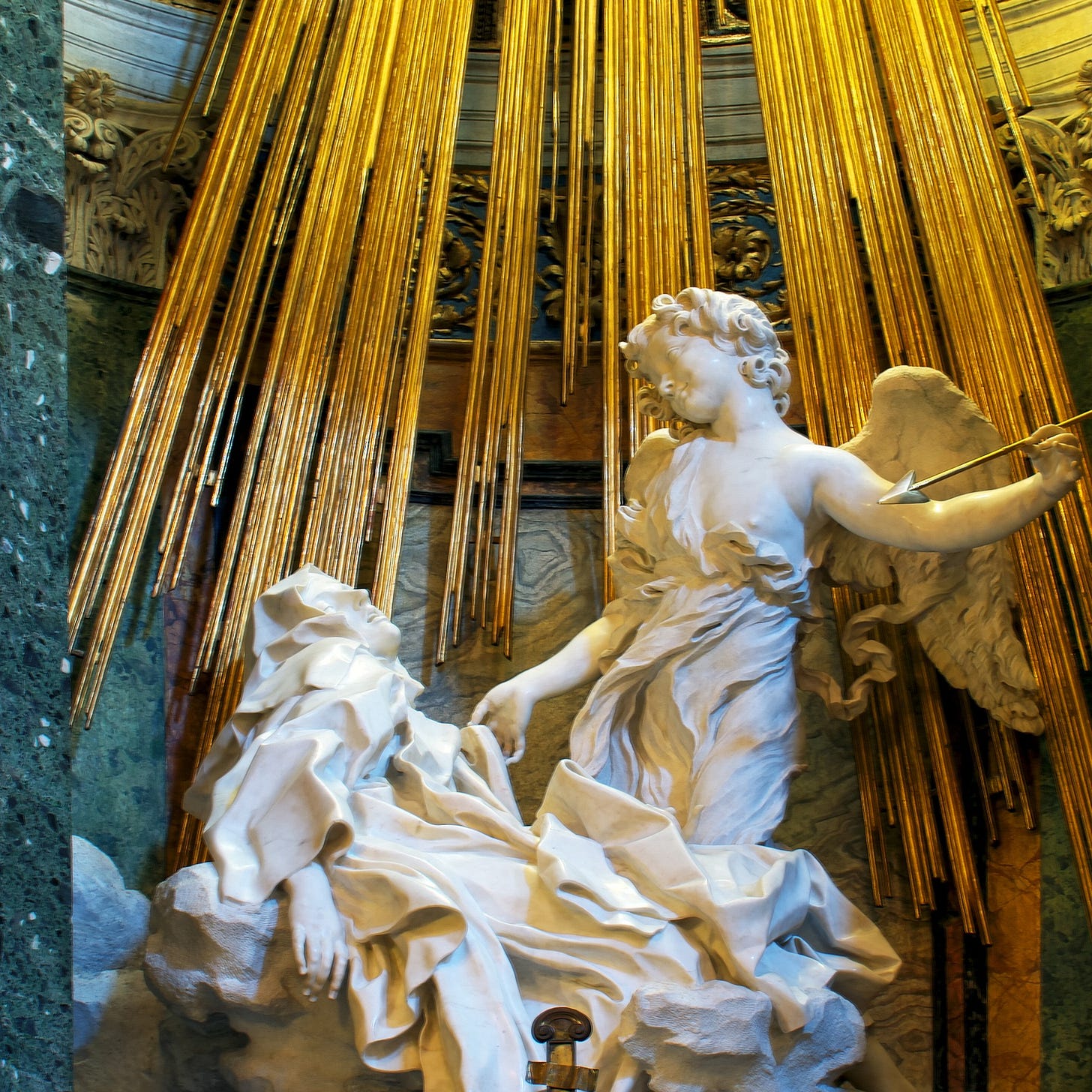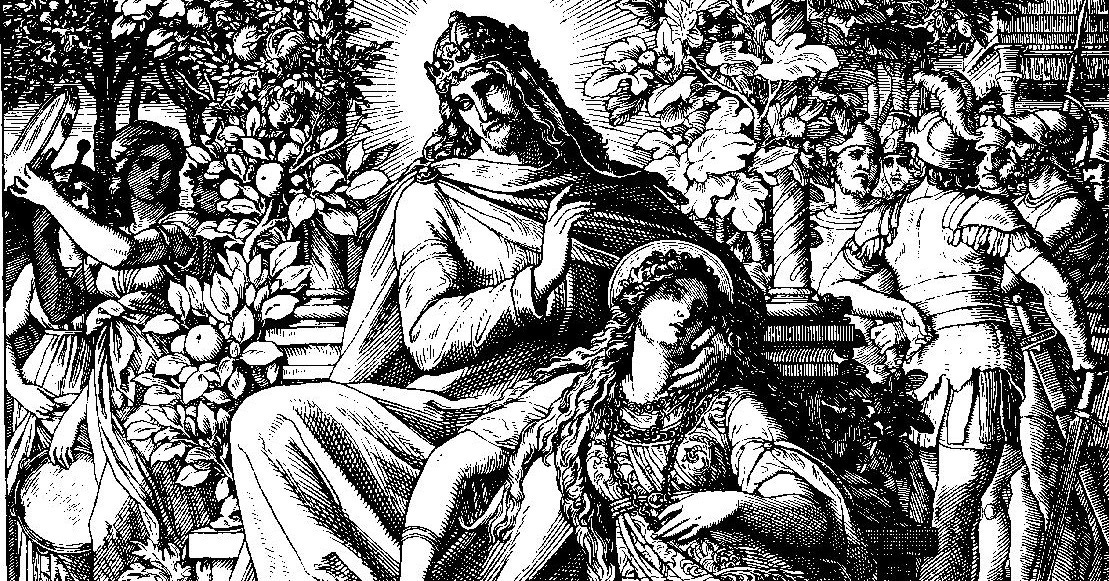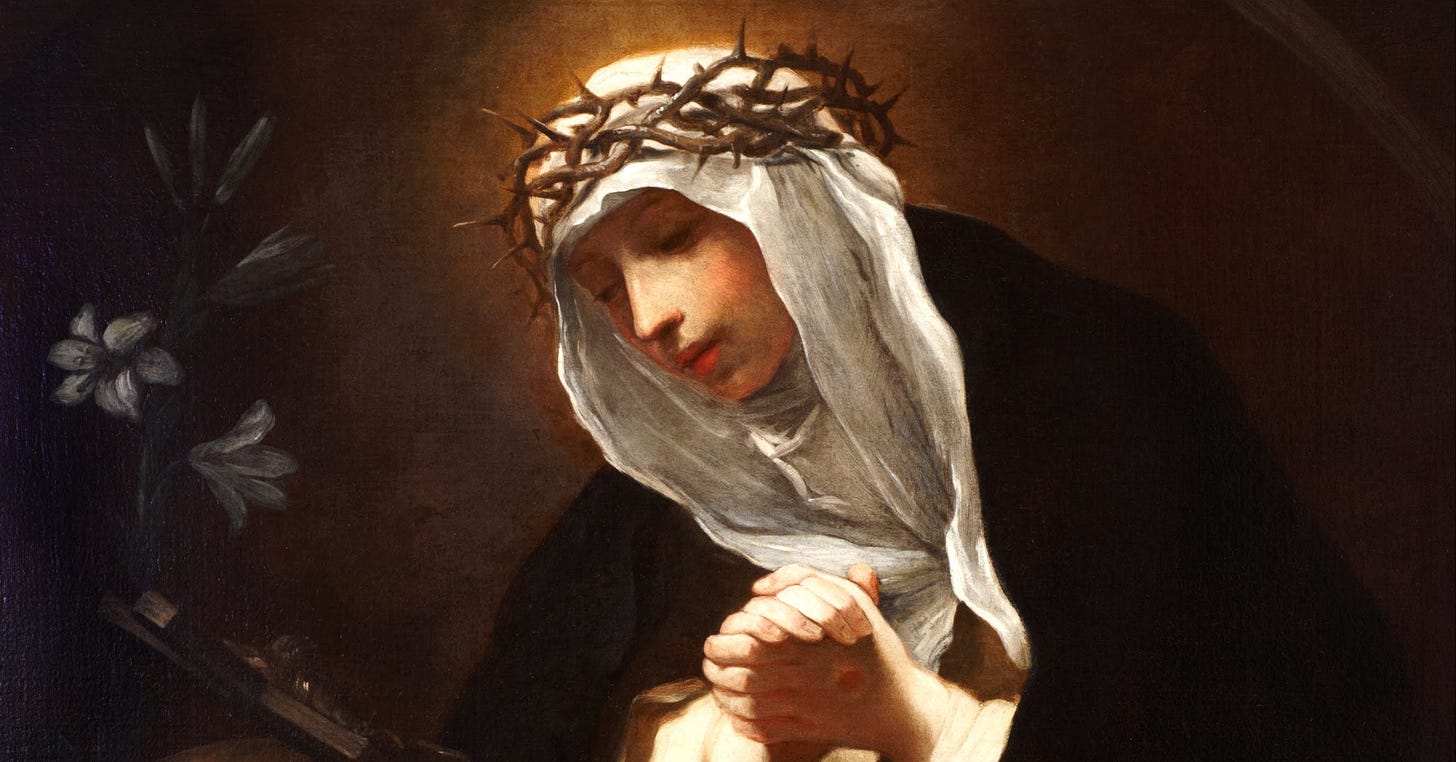A Love Story: 5 Christian Books on Bridal Mysticism
Finding ecstasy and rest in God
The soul longs for divine intimacy with God.
Drawing from the vivid imagery of Song of Songs and the theology of St. Paul in Ephesians, several Christian mystics have presented the spiritual life as a bride yearning for her husband.
The ascent of the soul to God is a love story—a journey of longing, purification, satiation, and ecstasy.
Yet, is this too much?
Many can only see sexuality through either a puritan or pornographic lens; but, the love between husband and wife is actually the primary image Scripture uses to express the love between the soul and God—and sometimes in very erotic language.
This “bridal mysticism” invites you into a love story, to see the soul’s ascent to God within a heavenly eros, a movement of desire and fulfillment.
And there are several great Christian mystics to help guide your way.
Reminder: you can support our mission and get all our members-only content for just a few dollars per month:
New, full-length articles every Tuesday and Friday
The entire archive of members-only essays
Access to our paid subscriber chat room
What is bridal mysticism?
Bridal mysticism is a form of Christian spirituality that expresses an intimate union between God and the soul, especially in the marital relation of Christ and His Church. The spiritual framework is found in St. Paul’s letter to the Ephesians, where he compares a husband’s love for his wife to Christ’s love for His Church (Eph 5:25-32). Christ is the Bridegroom, and the Church is the Bride; and they come together, like man and wife, to form one flesh: with Christ as the Head and the Church as the Body (Eph 5:23).
Within this spousal imagery, the mystics express an intimate longing for God, to satiate in the divine in a passionate, transformative way. The mystics read the Song of Songs as an allegorical commentary on the soul’s yearning for God, which expresses the relationship between the soul and God in erotic terms. Like a beloved yearning for her lover, so too does the soul yearn for union with God—and when the soul is able to satiate in God, the experience is ecstatic.
You may think this is some medieval oddity, but the concept of marital love as an image of the love between God and the soul has deep roots in the Old Testament.
Is Bridal Mysticism in the Bible?
While bridal mysticism is well-rooted in the Christian tradition, many, if not most, Christians are unfamiliar and even unsettled by the poetic romance and erotic imagery. You should recall, however, that eros, your natural love to satiate in beauty and be happy, is not an immoral longing nor is it contrary to agape, the supernatural selfless love received by grace. Many Christians would note that the love between husband and wife is arguably the primary image of God’s love in Scripture.
Ezekiel speaks of Israel as a young maiden whom God bathes and takes as His bride (16:6-14). It uses romantic imagery to reveal how God selected His chosen people. Moreover, the erotic images of Ezekiel are rivaled by the vivid sexual allusions found in the Song of Songs, a book Christians claim is inspired by God and given to aid you in your salvation. Further, the covenant at Mount Sinai is often read as a marriage covenant (Ex 19:1-9), and Israel’s idolatry against God is expressed as adultery against Him (Ezek 16:15-58). The New Testament perfects this in the marriage imagery discussed above between Christ and His Church (Eph 5:25-32), with Christians becoming “one flesh” with Christ as seen in the imagery of the Holy Eucharist (John 6:35–58).
Christians see God using man’s natural eros as an image of a spiritual eros between God and the soul throughout salvation history.
What are the classic books on bridal mysticism?
There are five classic texts that draw, to various degrees, on imagery that could be categorized as bridal mysticism—a soul that yearns to satiate in God, like a wife to her husband, and terminates in an ecstatic experience. Though uncommon now, it was quite common in Christian literature to always refer to the soul in the feminine form. The soul was a “she,” as all graced souls are part of the Bride of Christ, the Church. As such, the writers would adopt the disposition of a yearning bride searching for her husband, God or often Jesus.
Here are the texts in chronological order:
1. Sermons on the Song of Songs (1135–1153) by St. Bernard of Clairvaux
St. Bernard of Clairvaux’s Sermons on the Song of Songs (1135–1153), a collection of 86 sermons, is the cornerstone of Christian bridal mysticism. The work takes the central biblical text, the Song of Songs, and uses the literal romance to provide a lush picture of the soul’s passionate desire for spousal union with God. St. Bernard portrays the soul as a bride yearning for intimate communion with God with an emphasis on spiritual longing, divine eros, and the transformative journey toward this mystical marriage through contemplation and grace.
“She who loves God is rightly called a bride, for by the affection of her heart she clings to him and is united with him, becoming one spirit with him in love.” (Sermon 45.8)
“When the Bridegroom, the Word, comes to the soul, he imparts such sweetness that she is drawn away from all earthly things, and in her love she desires only to remain with him.” (Sermon 83.3)
The work was profoundly influential. Written for his Cistercian monks, the sermons blend exegesis, personal devotion, and theological depth. St. Bernard’s insights shaped the later mysticism of St. Teresa of Avila and St. John of the Cross by framing the ascent of the soul as a dynamic love story. Christians treasure the sermons by St. Bernard, because they reveal divine-human intimacy with a beautiful, rich intensity.
You should read this text and read it deeply. It is a core, foundational text in Christian mysticism at large.
2. The Dialogue (1377–1378) by St. Catherine of Siena
The Dialogue by St. Catherine of Siena, written around 1377–1378, is a profound work of Christian bridal mysticism, presenting a series of visionary conversations between St. Catherine and God, where the soul’s intimate union with Christ, the Bridegroom, is depicted as a spousal relationship rooted in love, charity, and suffering. Drawing on the Song of Songs and Ephesians 5, Catherine portrays the soul—and the Church—as the bride of Christ, united through the “marriage” of divine love, with the Eucharist and Christ’s Passion serving as the bond that purifies and transforms the soul for eternal communion.
“By this light [of grace] the soul becomes drunk with love for me, her Bridegroom, and she is united with me in a union that no one can break, for she has tasted and seen my Truth.” (The Dialogue, trans. Suzanne Noffke, p. 65)
Written in her native Tuscan dialect as a guide for her spiritual followers, the text combines mystical theology with practical calls to reform and service, emphasizing the soul’s ardent desire to “wed” Christ through self-sacrifice and devotion. Its vivid bridal imagery and focus on reciprocal love influenced later mystics and solidified St. Catherine’s place as a key figure in the tradition of spousal mysticism.
As an aside, Christians also look to St. Catherine, a tertiary Dominican, as profound, female prophetic voice, especially regarding the problems of the Avignon papacy.
3. Revelations of Divine Love (1395) by Julian of Norwich
Revelations of Divine Love by Julian of Norwich, written around 1395, is a seminal work in Christian bridal mysticism, presenting sixteen visions or “showings” that depict the soul’s intimate, loving union with Christ, the Bridegroom, through a compassionate and often maternal lens. Also drawing on the Song of Songs and the spousal imagery of Ephesians 5, Julian portrays Christ’s love as a tender, nurturing embrace, where the soul, as bride, is united to God in a relationship marked by mercy, suffering, and divine joy.
“And thus I saw that God rejoices that he is our Father, and God rejoices that he is our Mother, and God rejoices that he is our true spouse, and that our soul is his beloved wife.” (Revelations of Divine Love, trans. Colledge and Walsh, p. 296)
It is important that you know that Revelations of Divine Love is the earliest known book written by a woman in English. The text reflects Julian’s anchoritic spirituality, emphasizing God’s all-encompassing love as a marital bond that heals and transforms the soul. Its unique blend of bridal mysticism with maternal imagery and optimistic theology (e.g., “All shall be well”) profoundly influenced later mystics and remains a cornerstone of medieval mystical literature.
Notably, she is not a canonized saint. Part of this is due to the fact her that her work fell into obscurity and, while preserved in monasteries, was effectively rediscovered in the 1900s. As such, it remains a wonderful example of bridal mysticism, but lacks the cultural and historical impact that other books on this list effected.
4. The Life of Teresa of Jesus (1565) by St. Teresa of Ávila
The Life of Teresa of Jesus (also known as The Book of Her Life), written around 1565 by St. Teresa of Ávila, is a foundational text in Christian bridal mysticism. The text chronicles the saint’s spiritual journey and mystical experiences, particularly her vivid encounters with Christ as the Bridegroom. Through autobiographical reflections, St. Teresa describes her soul’s progression toward divine union, most notably in the transverberation, where an angel pierces her heart with a fiery dart, symbolizing the ecstatic, spousal love that unites her to Christ.
“I saw an angel very near me, on my left side, in bodily form, which is not usual with me; for though angels are often represented to me, it is only by the vision of the mind. But this time it was not so. This angel was small, very beautiful, his face so aflame that he seemed to be one of those highest angels who appear all on fire. They must be those they call cherubim, but they did not tell me their names. I saw in his hands a long golden spear, and at the end of the iron tip there seemed to be a point of fire.
This he plunged into my heart several times, so that it penetrated to my entrails. When he drew it out, I thought he was drawing them out with it, and he left me completely afire with a great love for God. The pain was so great that it made me moan several times; and yet so surpassing was the sweetness of this greatest pain that I could not wish to be rid of it, for the soul is satisfied now with nothing less than God. The pain precedes the sweetness, but afterward all is sweetness.”
(The Life of Teresa of Jesus, trans. Kavanaugh and Rodriguez, p. 322–323)
Rooted in the imagery of the Song of Songs and Ephesians 5, the text portrays the soul as a bride drawn into intimate communion with God through prayer, suffering, and contemplation—which all culiminates in spiritual marriage. Written for her Carmelite confessors, St. Teresa’s vivid, accessible prose blends personal narrative with mystical theology, profoundly influencing later mystics and establishing her as a central figure in the bridal mysticism tradition.
5. The Living Flame of Love (1585) St. John of the Cross
The Living Flame of Love, written by St. John of the Cross around 1585, is a profound poetic and prose commentary in the Christian bridal mysticism tradition, describing the soul’s ultimate union with God as a spiritual marriage marked by intense, transformative love. Drawing on the imagery of the Song of Songs and Ephesians 5, John portrays the soul as a bride consumed by the “living flame” of divine love, which purifies and unites her with Christ, the Bridegroom, in an ecstatic, Trinitarian embrace.
“O living flame of love that tenderly wounds my soul in its deepest center! Since you are no longer oppressive, now consummate, if it be your will, and rend the veil of this sweet encounter!” (The Living Flame of Love, trans. Kavanaugh and Rodriguez, p. 639)
Written as a lyrical exposition of four stanzas of his own poetry, the text explores the soul’s journey through the dark night of purification to the radiant, spousal intimacy of divine union, where God’s love burns within the soul without consuming it. Its dense, mystical theology and vivid imagery of love’s fire make it a cornerstone of Carmelite spirituality and a key work in bridal mysticism, complementing the visions of mystics like St.Teresa of Ávila.
What do you think?
Bridal mysticism is rooted in both Christian tradition and the Bible, but many find its imagery unsettling. Why do you think that is? Often times we, as moderns, can only think of sexuality in either a puritan or pornographic way. But the Christian tradition, and even the Bible, uses man’s natural eros as the primary analogue for the love between the soul and God, e.g., God and Israel, Christ and His Church.
What do you think?—a mystery to be explored or too much?
Dcn. Harrison Garlick is a deacon, husband, father, Chancellor, and attorney. He lives in rural Oklahoma with his wife and five children. He is also the host of Ascend: The Great Books Podcast. Follow him on X at Dcn. Garlick or Ascend.






Bridal mysticism, I love the sound of those words. Nice finding. And excellent choice of books, three of them formerly unknown to me. Yet more choices to comfortably read, thank you.